In digital marketing, saying “thank you” can be your brand’s secret weapon. Thank you cards can build loyalty, spark repeat business, and set you apart from competitors who overlook the human side of customer relationships.
Whether handwritten or using a thank-you-card maker, a well-timed thank-you card does more than acknowledge a transaction; it deepens a connection.
We’ll reveal the 10 perfect moments to send a thank you card and why missing them could cost your brand more than you think.
Let’s get started!
The Business Impact of Thank You Cards
Did you know that 68% of customers stop doing business with a brand simply because they feel unappreciated?
A thank you card may seem small, but its impact on your business can be surprisingly powerful. Here are some reasons why your business should start handing out thank-you cards:
- Increases customer retention: Customers who feel valued are far more likely to stick around. Research from Bain & Company shows that increasing customer retention by just 5% can boost profits by 25% to 95%. A personalized thank-you card signals that you see your customers as more than transactions.
- Differentiates your brand: Most brands chase attention through ads and algorithms. Thank you cards take a different route. They slow the interaction and make it personal. This kind of touchpoint not only feels unexpected, but it also makes your brand memorable in a sea of sameness.
- Strengthens emotional connection: Gratitude triggers positive emotions. When a customer receives a thank-you card, especially one handwritten or tailored to them, it creates a sense of connection. That emotional bond builds trust and makes customers more likely to return and to recommend your brand to others.
- Encourages word-of-mouth and referrals: People talk about moments that surprise them. A thoughtful thank you card can easily become a screenshot on social media or the subject of a conversation with friends. It’s a quiet but powerful way to generate organic marketing and positive word-of-mouth.
- Reinforces brand values: A thank you card is a subtle but effective way to reinforce what your brand stands for. Every card is an extension of your brand experience and a chance to leave a lasting impression.
10 Timely Moments to Send Thank You Cards to Customers
Timing matters. Sending a thank you card at the right moment shows your customer you’re paying attention and that you care. Here are ten great times to express gratitude that can deepen loyalty and make your small business stand out:
1. After a first purchase
Think of a customer’s first purchase as the start of a relationship. Sending a thank you card after this moment acknowledges and reinforces their decision to choose your brand. It shows that you’re not just focused on making a sale but on creating a positive experience from the very start.
This gesture can ease any hesitation a first-time buyer might have and open the door to future interactions. It sets a tone of thoughtfulness and trust, increasing the chances that the customer will return, leave a review, or recommend your business to others.
Example: “Thanks so much for your first order, Sarah! We’re thrilled to have you with us. If you have any questions, we’re just a message away.”
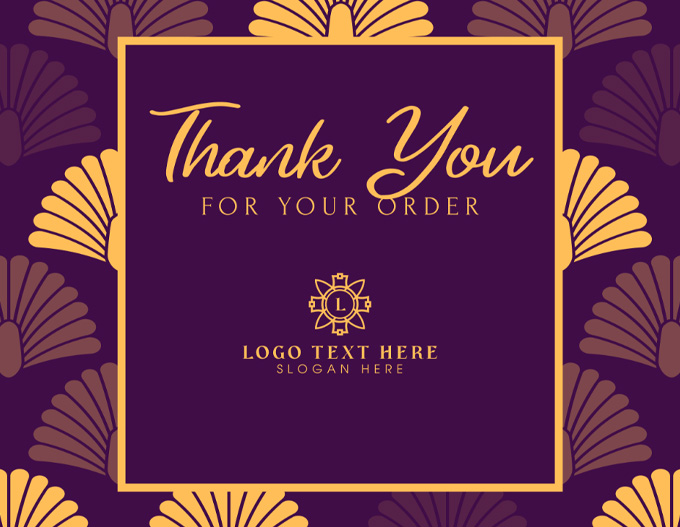
Fancy Me by BrandCrowd
2. After a referral
When customers refer someone to your business, that means they’re impressed with your services. They’re vouching for you and contributing to your bottom line at the same time.
That kind of trust deserves recognition. A thank you card lets them know you noticed and appreciate the referral.
Acknowledging referrals personally reinforces that their support makes a real difference. Adding a gift voucher or a small discount on their next purchase can further encourage continued advocacy. This creates a loop of goodwill and organic growth that’s often more effective than paid advertising.
Example: “Thank you for referring a friend to us! Your support means the world, and we’re so glad you’re sharing the love.”
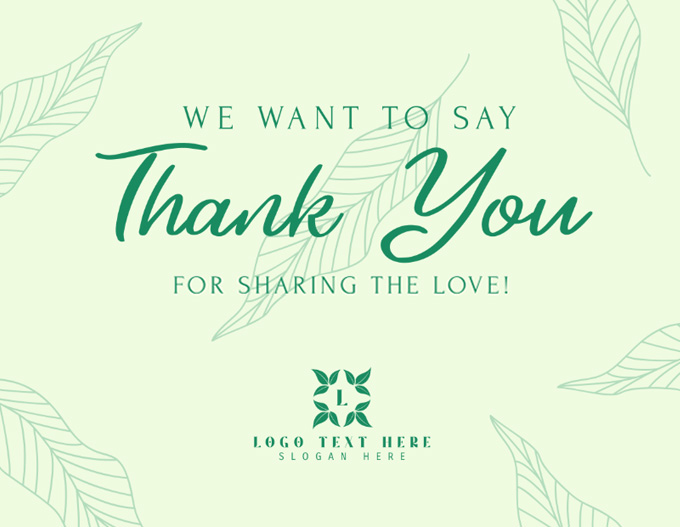
Elegant Leafy Pattern by Design
3. On the anniversary of their first purchase or signup
Marking the anniversary of when a customer first joined or made a purchase is a simple yet powerful way to show long-term appreciation. It reminds customers you value their loyalty, not just their most recent activity.
This type of thank you card helps nurture ongoing relationships. Over time, it strengthens emotional ties and keeps your brand at the top of your mind without being overly promotional or sales-focused.
Example: “One year already! Thanks for being with us since [month/year]. We appreciate your continued support more than you know.”
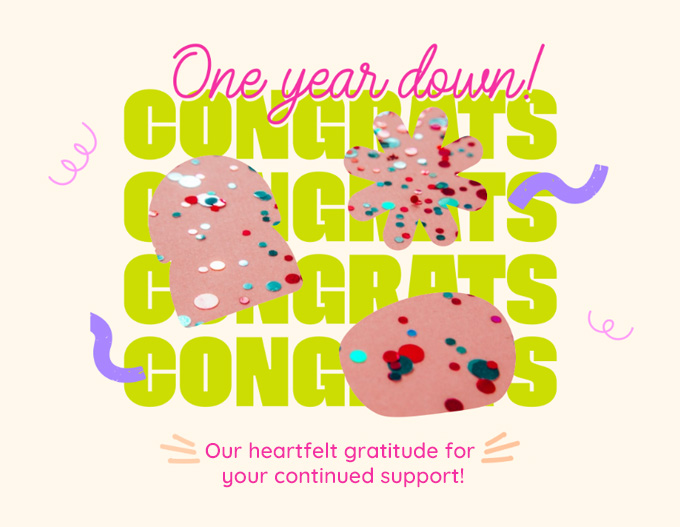
Achievers Anniversary Celebration by BrandCrowd
4. After resolving a complaint or issue
Handling a complaint well is essential, but what you do afterward can matter even more. Sending a thank-you card after resolving a customer issue shows that you value the relationship enough to follow up with kindness and professionalism.
It also communicates humility and empathy. Rather than ignoring a difficult moment, you turn it into an opportunity to build trust. This is also an opportunity to deepen the relationship beyond what it was before the issue arose.
Example: “Thanks for your patience while we sorted that out. We’re grateful for your understanding and glad we could make things right.”
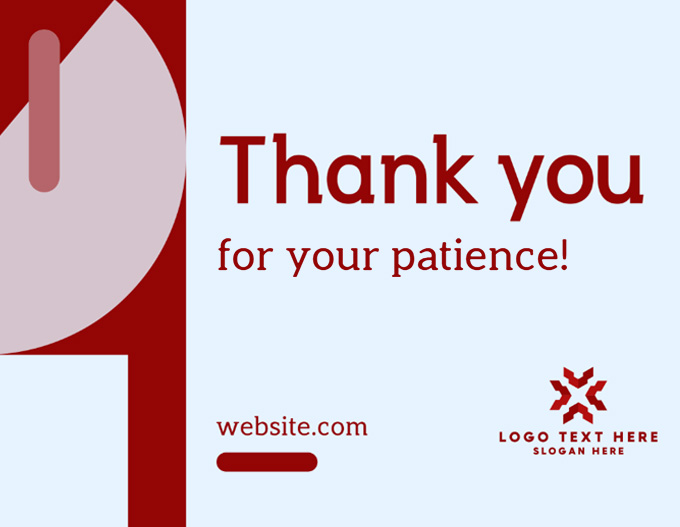
Modern Solids Thank You Card by Design
5. After a big order or milestone purchase
Large or repeat purchases reflect a high level of trust from the customer. A thank you card after a significant transaction acknowledges their loyalty and investment in your brand.
This recognition makes the customer feel seen and appreciated. It can also encourage future purchases, especially when the thank you feels personalized and sincere rather than automated or transactional.
Example: “Thank you for your recent order. We noticed it was a big one! We’re honored to have your trust and look forward to serving you again.”
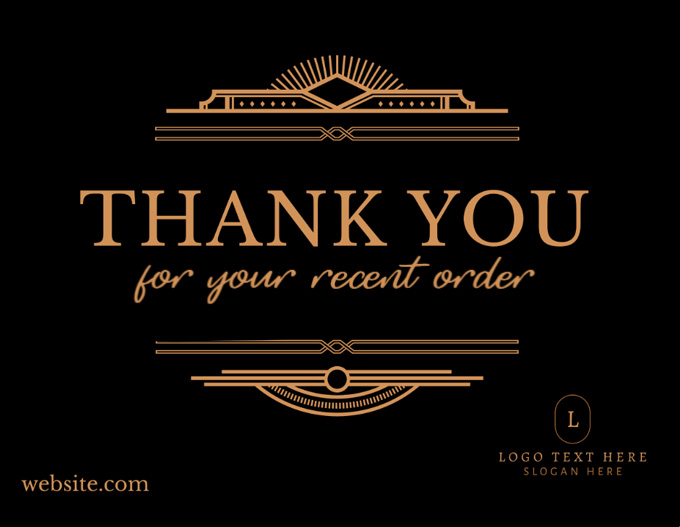
Like Gatsby Thank You Card by BrandCrowd
6. After an event or meeting
Whether virtual or in person, events and meetings take time and attention. Following up with a thank you card shows you’re grateful for the opportunity to connect and value the relationship beyond the event itself.
This can leave a lasting positive impression and help your brand stand out. It’s a respectful and thoughtful gesture that often leads to stronger follow-ups and continued interest.
Example: “Thanks for joining our product demo yesterday; connecting was great! We appreciate your time and hope to work with you soon.”
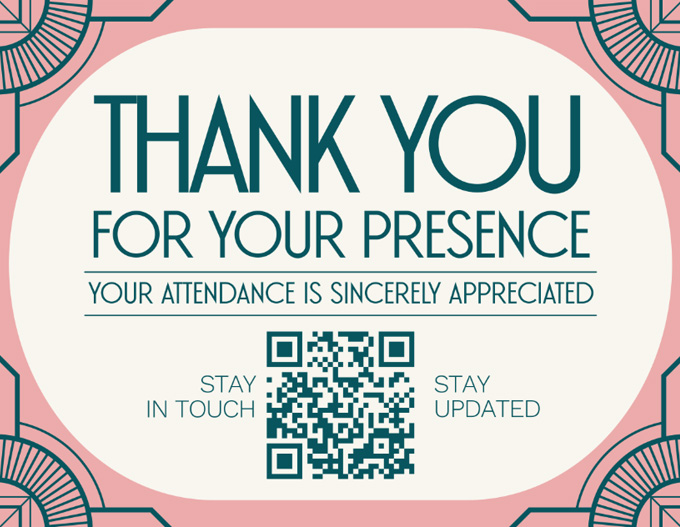
Elegant Art Deco Thank You Card by Design
7. On a customer’s birthday (or other personal milestone)
Recognizing personal moments like birthdays or milestones adds a human touch to your brand. It shows customers that you see them as individuals, not just buyers or leads.
These kinds of gestures strengthen the emotional side of your relationship with the customer. A birthday thank you card, even a simple one, can become a decisive moment of connection and goodwill.
Example: “Happy Birthday, Alex! We hope your day is filled with joy. Thanks for being a part of our community!”
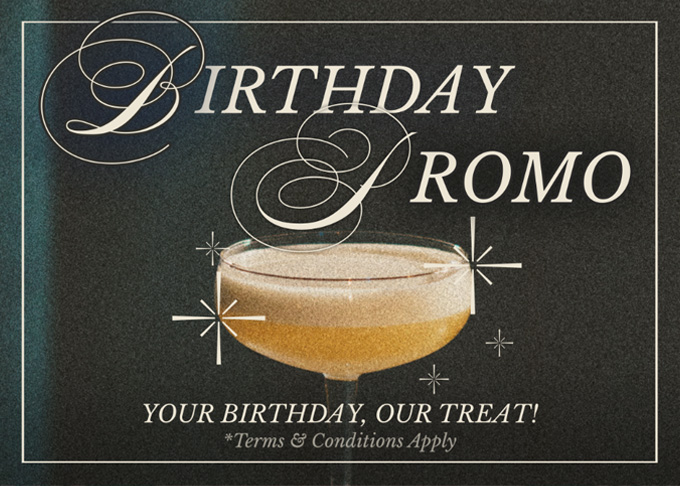
Rustic Birthday Promo by BrandCrowd
8. After a social media mention or tag
Customers mentioning your brand online through posts or UGCs give you visibility and public validation. Responding with a thank-you card shows you’re listening and genuinely appreciate the attention.
This encourages further engagement and builds a deeper connection. Customers who feel seen are more likely to become brand advocates and share their positive experiences again.
Create a Facebook Post using our tool so you can easily share your gratitude and create a community of supporters simultaneously.
Example: “We saw your post and want to thank you for your kind words and support! It means a lot to see our work making a difference.”
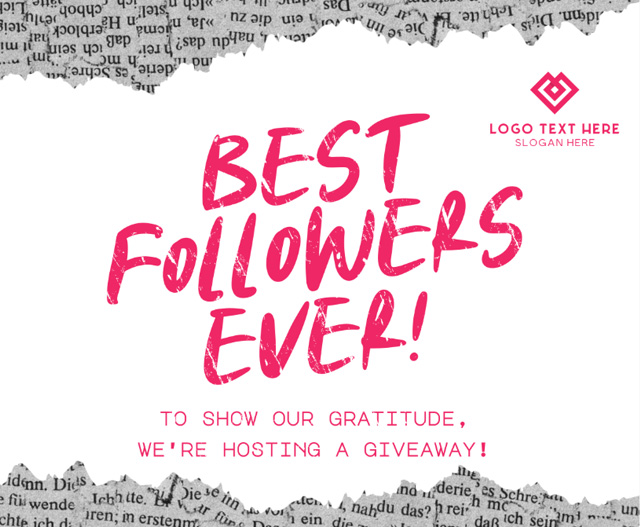
Grunge Thank You Followers by Design
9. During the holiday season
The holidays offer a natural moment to reflect and express gratitude. A thank you card during this time feels festive, thoughtful, and appropriate, without needing a specific reason.
It also lets customers know you appreciate their support throughout the year. A holiday thank you card strengthens relationships and sets the tone for continued loyalty into the new year.
example: “Wishing you a joyful holiday season! Thank you for being a valued part of our year. We can’t wait to serve you soon!”
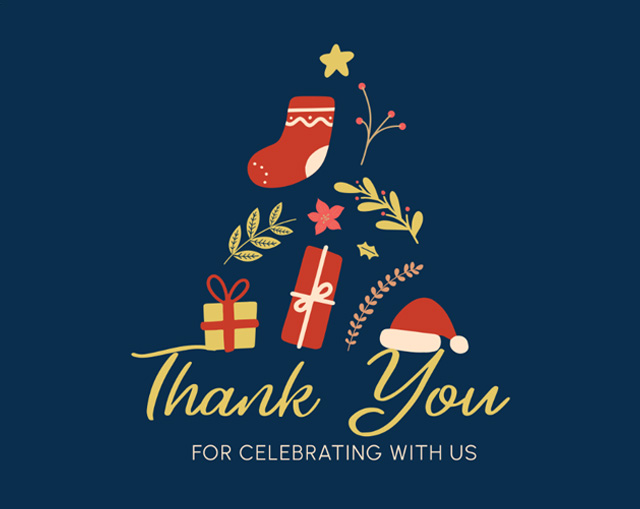
Christmas Tree Thank You Card by BrandCrowd
10. After receiving a review or testimonial
Reviews and testimonials help build trust with future customers, so it's essential to recognize that effort when someone takes the time to leave one. A thank you card acknowledges their contribution and reinforces the relationship.
It also encourages future feedback and shows that your brand values customer voices. Over time, this can create a stronger community and a steady flow of positive word-of-mouth marketing.
Example: “Thank you for your kind review! Your feedback helps others find us, and we’re so grateful for your support.”
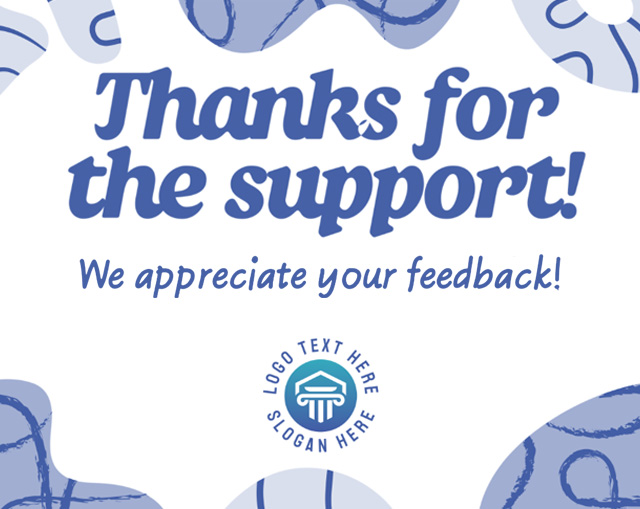
Playful Organic Abstract Thank You Card by Design
Handwritten Notes vs. Virtual Thank You Emails: Which Is Better?
Thank you cards can be powerful, whether they’re handwritten or digital. But which one is right for your brand? The truth is, both have their strengths. Handwritten notes feel more personal. They take time to create, which makes them stand out.
When a customer receives one, it feels like a genuine gesture, building stronger loyalty. However, they take longer to send and are harder to do at scale.
Virtual thank you emails, on the other hand, are quick, easy, and scalable. With just a few clicks, you can send them to hundreds (or thousands) of customers. They’re perfect for first-time purchases or general appreciation messages.
They’re also better for boosting brand recognition because you can easily integrate visual elements. For example, you can create seasonal logos using a logo maker to celebrate certain occasions.
While they may not feel as special as a handwritten note, a well-written, personalized email still shows you care, which can go a long way.
Here’s a simple table to show the difference between the two thank-you cards:

Best Practices for Crafting Effective Thank You Cards
Here are some practical tips to help your thank you cards leave a lasting impression:
- Personalize whenever possible: Use the customer’s name. Mention what they purchased, when they joined, or what they did (like leaving a review or attending an event). Small personal touches show the message wasn’t copy-pasted and make the note feel more sincere.
- Keep it simple and sincere: You don’t need fancy words or corporate jargon. Just say thank you clearly and from the heart. One or two short paragraphs are usually enough. Be honest, warm, and human.
- Match the tone to your brand: Your thank-you card should feel like it came from your business. If your brand is friendly and casual, keep the tone light. If your brand is elegant or high-end, use a more polished tone but still make it personal.
- Add a personal signature (even digitally): A handwritten signature adds a nice finishing touch to a physical card. Consider using a real person’s name and title instead of a generic "Team" or "Support" sign-off for emails. It builds trust and feels more human.
- Include a small extra: If it fits your budget, you can add a little bonus like a discount code, a small gift, or an exclusive invite. It’s not required, but it can make the thank you even more memorable. Just ensure it feels like a genuine gesture, not a sales tactic.
- Don’t wait too long: Timing matters. A thank you card that arrives a few days after an interaction feels thoughtful. One that comes weeks later might feel out of place or automated. Try to send your message while the moment is still fresh.
- Use quality materials (for printed cards): If you’re mailing cards, invest in quality paper and envelopes. It shows care and attention to detail. A well-made card can reflect the quality of your brand and make the recipient feel valued.
Design Your Thank You Card Today
Thank you cards might seem like a small gesture, but their impact on your business is anything but.
Sending a timely, thoughtful thank you builds stronger customer relationships, encourages loyalty, and sets your brand apart from competitors who overlook the power of gratitude.
Read More on Designs Here:
FAQs About Thank You Cards
Why are thank you cards important for businesses?
Thank you cards help build emotional connections with customers, increasing loyalty and encouraging repeat business. They show appreciation, making customers feel valued rather than just a sale.
When is the best time to send a thank you card to a customer?
The best times include after a first purchase, following a referral, after resolving an issue, on anniversaries, during holidays, and other key moments in the customer journey.
Are handwritten thank you notes more effective than digital ones?
Both have benefits. Handwritten notes feel more personal and memorable, but are harder to scale. Digital notes are quick, easy to personalize, and great for reaching many customers.
What should I include in a business thank you card?
Personalize the message, clearly say thank you, match your brand’s tone, and, if appropriate, include a small incentive or contact info for follow-up.
How do I measure the effectiveness of thank you cards in my customer retention strategy?
Track repeat purchases, customer feedback, referral rates, and engagement after sending thank you cards. You can also run surveys asking customers about their experience with your brand’s communication.
Shayne Jain is a content writer with 7 years of experience specializing in creating engaging and impactful content. Her passion for writing began at age 8, when she started crafting short stories and songs. When she’s not writing, you can find her kicking balls on the football field or immersed in a good video game.
Original Artwork by Selwyn Legaspi
Written by DesignCrowd on Friday, June 13, 2025
DesignCrowd is an online marketplace providing logo, website, print and graphic design services by providing access to freelance graphic designers and design studios around the world.
